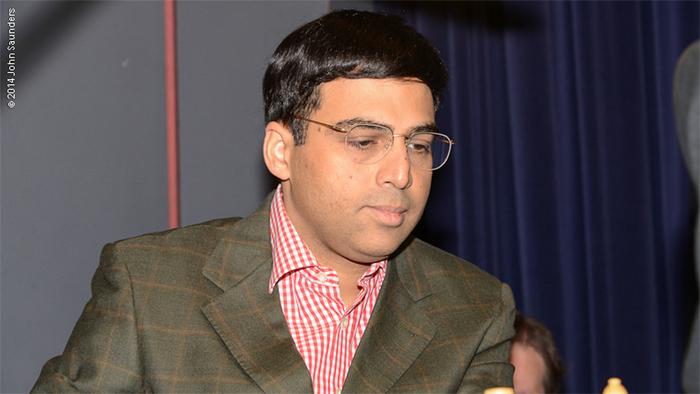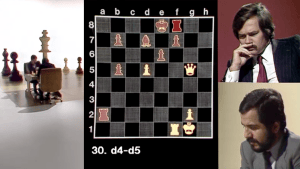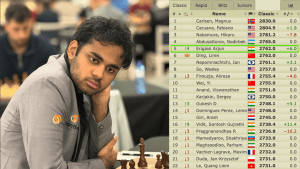
Anand Beats Adams, Wins London Chess Classic On Tiebreak
GM Viswanathan Anand won the 2014 London Chess Classic on Sunday. The 45-year-old Indian grandmaster edged out GM Vladimir Kramnik and GM Anish Giri on tiebreak.
Anand's first place was based on number of wins with Black, and since there was no other player to win a game with the black pieces, his win against Adams on Sunday did the trick.
Giri and Kramnik drew their mutual game in the last round and so did Caruana and Nakamura.
Photo © John Saunders.
Vishy Anand was in an excellent mood during his press conference on Sunday. He had beaten Mickey Adams, and with Caruana-Nakamura heading to a draw, he knew he was going to win the London Chess Classic on tiebreak.
The Indian, who turned 45 recently, could be happy with his year 2014, in which he won three tournaments: “Given how things were looking last year obviously I’m very satisfied with this year. Khanty, Bilbao… even Sochi, as I think I played well but my nerves gave way at the wrong moment.”
Anand pointed out that the next Candidates’ Tournament is in 2016, so for the first time in many years, he won't be “preparing against a single opponent” in the near future!

His game with Adams must have involved some world championship preparation, though. After the match it was revealed that the Englishman was part of Carlsen's team. And the opening was...a Berlin.
The players followed the ninth game, the shortest of the match, in which Anand had equalized quickly with an early Bc8-a6-b7. Adams deviated with 11.Rd1 and 12.g3 (a move that is usually played later), and again Anand put his bishop on b7 as the first new move.
Adams played c4, and Nd5, and Anand chopped it off the board. According to GM Dejan Bojkov, who analyzed the game for us, White would have maintained a slight edge if he had taken back with the pawn, the first critical moment of the game.
Anand was at least equal when, on his turn, he got a knight on d4 and then tried his luck in a knight endgame. That was a good bet as after trading the rooks Adams made a decisive mistake.

Before the final round, Giri vs Kramnik was the key game as the winner would automatically win the tournament outright. The two had played each other very recently in Qatar, when Kramnik won convincingly — but then he was White.
The game was a Catalan, an opening in which both players feel much at home. Kramnik was the first to surprise, with the “ugly” pawn move 11...c6 (“It looks absolutely ridiculous.”)
Giri said at the press conference that he had in fact seen it in his preparation, but his thoughts went: “I shouldn’t be paranoid –- he’s never played it so why should he play it today?”
Black was fine out of the opening and obtained some winning chances when Giri played 26.e4, “disgusted” about his position. The nice pawn sac 26...d4! yielded Kramnik the initiative.
A curious moment was move 30.
Here, Giri's rook trade 30.Ra7 was “the only move” according to Kramnik. It was a nice example of a world champion having better vision and understanding than an engine running 20 ply deep max, as is usually shown online.
The engine's limited vision will evaluate the position as equal, while it is really unpleasant for White after e.g. 30.Qd4 Bc5 31.Qa4 g5 32.Bc3 Bd3 33.h3 Kg7.
Giri continued to play very accurately and held the draw — another sign that the young Dutchman has made serious progress in 2014. On the January 2015 list he will still be the world number seven (one place higher than Kramnik!), with a rating 50 points higher than a year ago!

At the press conference Alexander Kotov's famous “tree of analysis” was discussed. These days the Soviet grandmaster's theory is considered valuable, but too rigid for practical play (according to Mark Dvoretsky and John Nunn, among others). The players seemed to confirm the modern interpretation.
Kramnik: “I really don’t know how it works. I just think and come up with it. I never have any structure. I read all these books and I never followed it. Something comes to my mind, I start one move and then I move to another. It’s a mess in my head.”
Giri: “When I think I’m completely lost or winning to be completely sure I start to check all the moves, which happens really rarely. In a normal position all reasonably strong players probably have some combination of an algorithm and inspiration.”

The playing hall during the final round. | Photo © Ray Morris-Hill.
The last game to finish was Caruana-Nakamura, another Berlin ending, and another very complicated one. Whereas commentator Nigel Short semi-jokingly “refused” to look at these endings in London, the games that were played in this tournament confirmed Kramnik's remark that it's simply a very interesting ending.
Especially around move 30 the position became rather sharp, and as it turned out, both players thought they were doing well.
Nakamura said: “The problem is I went completely insane. I thought I was just mating.” In reality, no big mistakes were made and both played a pretty good game.

Let's finish with the following paragraphs from the official press release by John Saunders, which sums things up nicely:
“It speaks volumes for the character of the man that he was able to bounce back from the disappointment of Sochi a few weeks ago to take this prestigious title in London. And prestige is a two-way street: Vishy Anand’s name on the trophy adds lustre to the London Chess Classic and means that all three world champions active during the tournament’s existence have now won it. Vishy’s win on tie-break is karmic compensation for losing out to Magnus Carlsen on tie-break in 2010 despite defeating him in the tournament.
Given that the event has now been in existence for five years and six events, it might be timely to publish our roll of honour: 2009 and 2010 Magnus Carlsen; 2011 Vlad Kramnik; 2012 Magnus Carlsen; 2013 Hikaru Nakamura; and now, 2014, Vishy Anand. You’d be hard pushed to find another 21st century tournament with a list of winners as impressive as that.”
2014 London Chess Classic | Final Standings
| # | Name | Rtg | 1 | 2 | 3 | 4 | 5 | 6 | Score | Perf |
| 1 | Anand, Viswanathan | 2769 |  |
1 | 1 | 1 | 3 | 1 | 7 | 2847 |
| 2 | Kramnik, Vladimir | 2768 | 1 |  |
1 | 3 | 1 | 1 | 7 | 2852 |
| 3 | Giri, Anish | 2775 | 1 | 1 |  |
1 | 3 | 1 | 7 | 2852 |
| 4 | Nakamura, Hikaru | 2793 | 1 | 0 | 1 |  |
3 | 1 | 6 | 2780 |
| 5 | Adams, Michael | 2745 | 0 | 1 | 0 | 0 |  |
3 | 4 | 2640 |
| 6 | Caruana, Fabiano | 2829 | 1 | 1 | 1 | 1 | 0 |  |
4 | 2700 |
Previous reports
- Round 4: Nakamura Beats Adams, Moves to Third Place in London
- Round 3: Three Draws In 3rd Round London Chess Classic
- Round 2: London R2: Adams Loses To Giri, Kramnik Crushes Nakamura
- Round 1: London R1: Adams Beats Caruana in Rollercoaster Game
- Blitz: London Classic Blitz: Adams Wins On Tiebreak
- Rapid: “Stonking Performance” For Nakamura At London's Super Rapidplay Open
- Preview: London Chess Classic Kicks Off Tomorrow


